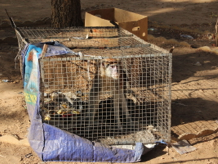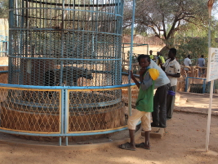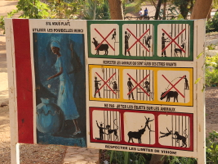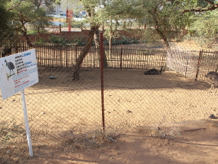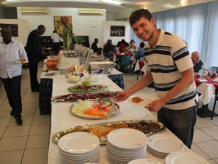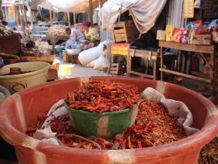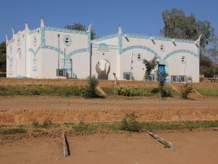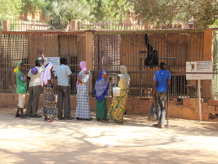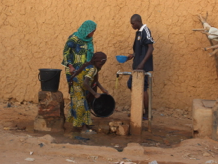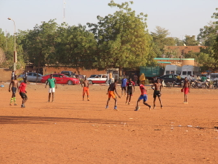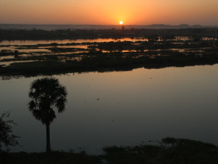From Houston to Sydney 2013

West Africa
2014
It was totally dark this morning as we walked from our bungalow room to the main building to have breakfast. The time was 6:25 am, and there was not even the hint of a glow on the horizon of a rising sun.
Mama had wanted us to be on the road by 6:30 am, but we decided to delay our departure until 7:00 am when we learned last night that breakfast was only served from 6:30 am onwards.
The reason for the early start was that we were going to drive to Kouré to see some examples of the rare, endangered, miniature giraffes – the last giraffes remaining in West Africa – and Mama thought they might be hard to find if we arrived too long after dawn.
The drive to Kouré took about half an hour longer than expected as our car travelled about 15 minutes out of Niamey along the wrong road before the error was discovered. Let’s be kind and blame the lack of lighting and the absence of signage on Niamey’s roads. Nonetheless, we arrived at the checkpoint at Kouré at about 8:30 am, and met the obligatory local guide who was going to help us find some giraffes.
The search began by driving a further 20 or so kilometres east of Kouré to Kodo (in Fakara commune) before turning off the sealed road and heading north along some dirt tracks. It wasn’t long before our obligatory local guide got out of the car, climbed up to the roof of the car, and we continued our journey with the obligatory local guide guiding Harouna by waving a stick in front of the windscreen from the roof.
It took almost an hour of driving along through the savannah countryside, sometimes along sandy tracks and at other times through fallow fields where sorghum or millet had been harvested, when we finally spotted a group of eight giraffes. It was time for photo taking to begin in earnest!
West Africa’s giraffes have been on the endangered list for several decades. They used to be found throughout the Sahel region as far west as Mali, but the small herds near Kouré in Niger are the last remaining examples of the West African giraffe. In 1982, the number had dwindled to just 92 animals as the result of poaching, but with careful conservation the number has now grown back to about 360 or so – still a tiny genetic pool for a species.
After spending time walking around the giraffes, many of which were young or adolescent, we drove further and managed to see another six. In round figures, we therefore saw between 4% and 5% of all the remaining West African giraffes in the world.
And what beautiful, graceful, and relatively tame, animals they were! Compared with the more common giraffes in east Africa, the West African giraffes are smaller in size (presumably an adaptation to the drier climate where the trees don’t grow as tall), and the coloured patches are paler and less red in colour. Yes, it took some time and effort to find them, but seeing the giraffes was a very special experience.
I could have stood and watched the giraffes all day, but as the giraffes were on the move, and they can walk more quickly than I can, the came came for us to depart and head back into Niamey. After returning to the capital, we made three fairly short stops.
The first visit was to the ‘Village Artisanal Wadata’, a showcase of Nigerien artisanship that was set up with financial aid from Luxembourg. Despite the promise of seeing traditional crafts being made, the area was mostly a dusty collection of souvenir and handicraft stalls for tourists, with a just few workshops making jewellery and shoes by folk who seemed very reluctant to have their photo taken without “un cadeau”. It was mildly interesting, but the incessant pressure to go into every ‘boutique’ (i.e. dusty shed) to look at even dustier wooden carvings took its toll, and we didn’t remain vary long, to the huge disappointment of many of the boutique owners.
Our second stop was far more interesting in my view. This was the Grand Mosque (Grande Mosquée), a truly impressive building constructed in Middle Eastern style in the mid-1970s by Libya. The building featured a tall minaret and a bulbous green dome that seemed quite out of character with West African culture, but I was told by the local people that they really liked the building, not least of which because of its huge size (it is supposed to be able to accommodate 10,000 people, but my guess is that this number would leave precious elbow room, or any other type of room for that matter). We were permitted inside in return for a small donation, and the interior was indeed impressive (see the panorama view at the end of today’s diary). According to one of my guide books, the climb up the 171 steps to the top of the minaret is well worth the effort, but when I asked about this, I was shown the butt of a broken key and told the remainder of the key was stuck in the lock, and so it couldn’t be opened. I assume the comment was true, because excuses tend to be solvable with a small bribe, and no bribe would be sufficient to instantly resurrect a broken key and lock.
Our third stop was the Small Market (Petit Marché), apparently a more picturesque and more atmospheric market than the Big Market (Grand Marché). The market was interesting enough, with its locally produced fruit and vegetables and common household goods, but it lacked much of the local colour, bustle and colour of regional markets that we had seen earlier on the trip, such as in Djenné and Sanga.
By the time we finished at the Petit Marché it was 1:00 pm, so we returned to our hotel for lunch. And what a lunch it was! Certainly one of the best meals we have seen in West Africa, the hotel had put on an extensive buffet with local and Western food, hot and cold, including dessert. Needless to say, Andrew and I made good use of the buffet, so much so that neither of us felt hungry enough to have dinner that evening. Great value indeed!
We had a rest during the heat of the day when the temperature reached 34 degrees Celsius, and met Mama and Harouna again at 3:30 pm. We had just one destination this afternoon, which was the National Museum of Niger. As many know, I am not a huge fan of museums, byt I felt the duty to check out this one, and I am very glad that I did so. It was quite unlike any other museum I have ever visited.
Housed in a large compound of some 24 hectares (or maybe 24 acres, it wasn’t too clear), with dispersed distinctive blue and white buildings, the interior displays are only a minor part of the museum. They do, however, display Niger’s cultural diversity very well, with displays of clothing, crafts, armaments, money, pottery, and so on.
By far the largest area of the museum is actually a zoo that houses an eclectic mix of birds and animals, usually in stark concrete cages with dense iron bars and wire netting that seem far too small for the animals in them. In many ways, the zoo was depressing, with lethargic and neurotic animals either trying to bash their way out of their unforgivably small cages, or walk in interminable circles, or spend their lives lying down on the bare concrete waiting for the years to pass until they die. And unlike zoos in the West, at this zoo is quite okay for people to feed the animals, taunt them or (in the case of the baboons) provoke them to perform tricks.
The range of animals was interesting in itself. There was a good range of hyenas, the vultures seemed to enjoy disembowelling some animal carcasses in their small cages, the lions seemed agitated in their cage that was only three or four times their body length, and the guide seemed particularly keen to show off the three-legged goat that couldn’t stand up properly and the hermaphrodite sheep. I think the crocodiles would have been happier if they had some water in their cages for swimming rather than bare concrete and stones. The staff helpfully enticed a hippo out from the water for a feed while we were there, giving us a very close view into its enormous mouth (a great camera video moment!). Puzzlingly, there were two emus from Australia (the only Australian animals present), and they were in a pen that was about ten times larger than the cage housing the male lion.
The least impressive part of the museum (in my opinion) was yet another “artisans’ compound”, which was really a front to see over-priced souvenirs. The most impressive part, I thought, was a large open-sided, tin-roofed structure that housed three enormous dinosaur skeletons that were recovered from the north of Niger. Said to be about 100 million years old, one of the skeletons was a huge ancient ‘super crocodile’ (sarcosuchus imperator – far larger than any crocodile that is alive today), while the others were (I think) an ouranosaurus and a something whose name I don’t know (no-one seems to) but which resembles an over-grown tyrannosaurus rex. They were all very, very big!
The other interesting exhibit was the famous (in this part of the world) Arbre de Ténéré. It was the last surviving acacia tree in what was once the Sahara forest. Still alive 400 kilometres from its nearest relative, it became an important road marker until 1973 when a Libyan truck driver accidentally crashed into the tree and killed it (I ask myself, what are the odds of hitting the only tree in the Sahara Desert?). The remains of the tree are now displayed in the National Museum, and a metal replica has been erected in Ténéré.
We returned to our hotel at 6:00 pm, in good time to find a place on the hotel terrace and watch the sun set across the Niger River. After the huge lunch we had enjoyed earlier in the day, we restricted ourselves to a couple of tonics and some peanuts. Sitting back and watching the bats fly overhead, with the wide river before us, it was hard to imagine that we were surrounded by desert and a couple of thousand kilometres from the sea.
Andrew and I have both enjoyed Niger far more than we expected. The geographical landscape is quite different to the areas we saw in Mali and Burkina Faso, the villages are distinctively different to those elsewhere because their dispersed layout and flimsy timber granaries, the people are gracious and hospitable, and importantly for us, the food is fabulous and affordable. Niamey has far more character and charm than Ouagadougou, managing to achieve a great balance between traditional culture and a modern (if impoverished) city.
It really is a pity that we haven’t planned to allow more time here in Niger.

Wednesday
15 January 2014
Day 19 - Niamey, Niger





































